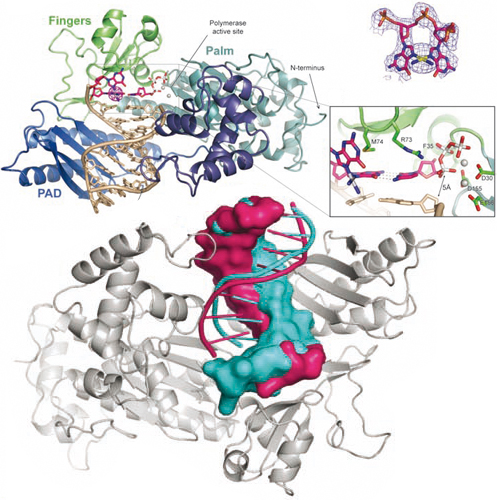Bypass of DNA Lesions Generated During Anticancer Treatment with Cisplatin by DNA Polymerase Eta
09-Nov-2007
DNA polymerase eta (Pol eta) is a eukaryotic lesion bypass polymerase that helps organisms to survive exposure to ultraviolet (UV) radiation, and tumor cells to gain resistance against cisplatin-based chemotherapy. It allows cells to replicate across cross-link lesions such as 1,2-d(GpG) cisplatin adducts (Pt-GG) and UVinduced cis–syn thymine dimers. We present structural and biochemical analysis of how Pol h copies Pt-GG–containing DNA. The damaged DNA is bound in an open DNA binding rim. Nucleotidyl transfer requires the DNA to rotate into an active conformation, driven by hydrogen bonding of the templating base to the dNTP. For the 3'dG of the Pt-GG, this step is accomplished by a Watson-Crick base pair to dCTP and is biochemically efficient and accurate. In contrast, bypass of the 5'dG of the Pt-GG is less efficient and promiscuous for dCTP and dATP as a result of the presence of the rigid Pt cross-link. Our analysis reveals the set of structural features that enable Pol eta to replicate across strongly distorting DNA lesions. Press commentaries: Welt Online Schwäbische Zeitung Online Innovations Report Wiener Zeitung LMU Presseinformation Abendblatt.de MorgenWeb.de Uni-Protokolle.de www.n-tv.de www.ad-hoc-news.de Lübecker Nachrichten www.LN-online.de www.GesundheitPro.de Uetersener Nachrichten www.Rhein-Zeitung.de www.frankenpost.de Osnabrücker Zeitung Other articles can be found under www.handelsbaltt.de, www.Pharmazeutische-Zeitung.de and Frankfurter Neue Presse by searching for Carell or Hopfner











